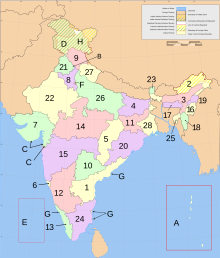India is federation with a parliamentary form of government, governed under the Constitution of India. It is a constitutional republic and representative democra, "in which majority rule is tempered by minority rights protected by law." Federalism in India defines the power distribution between the centre and the states. The government is regulated by a checks and balances defined by Indian Constitution, which serves as the country's supreme legal document.
Constitution:-
The Constitution of India, the longest and the most exhaustive among constitutions of independent nations in the world, came into force on 26 January 1950. The preamble of the constitution defines India as a sovereign, socialist, secular, democratic republic. India has a bicameral parliament operating under a Westminster-style parliamentary system. Its form of government was traditionally described as being 'quasi-federal' with a strong centre and weaker states, but it has grown increasingly federal since the late 1990s as a result of political, economic and social changes.
President and Prime Minister:-
The President of India is the head of state elected indirectly by an electoral college for a five-year term. The Prime Minister is the head of government and exercises most executive power. Appointed by the President, the Prime Minister is by convention supported by the party or political alliance holding the majority of seats in the lower house of Parliament. The executive branch consists of the President, Vice-President, and the Council of Ministers (the Cabinet being its executive committee) headed by the Prime Minister. Any minister holding a portfolio must be a member of either house of parliament. In the Indian parliamentary system, the executive is subordinate to the legislature, with the Prime Minister and his Council being directly responsible to the lower house of the Parliament.
Legislature:-
The Legislature of India is the bicameral Parliament, which consists of the upper house called the Rajya Sabha (Council of States) and the lower house called the Lok Sabha (House of People). The Rajya Sabha, a permanent body, has 245 members serving staggered six year terms. Most are elected indirectly by the state and territorial legislatures in proportion to the state's population. 543 of the Lok Sabha's 545 members are directly elected by popular vote to represent individual constituencies for five year terms. The other two members are nominated by the President from the Anglo-Indian community if the President is of the opinion that the community is not adequately represented.
Judiciary:-
India has a unitary three-tier judiciary, consisting of the Supreme Court, headed by the Chief Justice of India, 21 High Courts, and a large number of trial courts. The Supreme Court has original jurisdiction over cases involving fundamental rights and over disputes between states and the Centre, and appellate jurisdiction over the High Courts. It is judicially independent, and has the power to declare the law and to strike down Union or State laws which contravene the Constitution. The role as the ultimate interpreter of the Constitution is one of the most important functions of the Supreme Court.
Administrative divisions:-
India consists of 28 states and seven Union Territories. All states, and the two union territories of Puducherry and the National Capital Territory of Delhi, have elected legislatures and governments patterned on the Westminster model. The other five union territories are directly ruled by the Centre through appointed administrators. In 1956, under the States Reorganisation Act, states were formed on a linguistic basis. Since then, this structure has remained largely unchanged. Each state or union territory is further divided into administrative districts. The districts in turn are further divided into tehsils and eventually into villages.
The 28 states and 7 union territories of India
States:
- Andhra Pradesh
- Arunachal Pradesh
- Assam
- Bihar
- Chhattisgarh
- Goa
- Gujarat
- Haryana
- Himachal Pradesh
- Jammu and Kashmir
- Jharkhand
- Karnataka
- Kerala
- Madhya Pradesh
- Maharashtra
- Manipur
- Meghalaya
- Mizoram
- Nagaland
- Orissa
- Punjab
- Rajasthan
- Sikkim
- Tamil Nadu
- Tripura
- Uttar Pradesh
- Uttarakhand
- West Bengal
Union Territories:
- Andaman and Nicobar Islands
- Chandigarh
- Dadra and Nagar Haveli
- Daman and Diu
- Lakshadweep
- National Capital Territory of Delhi
- Puducherry

No comments:
Post a Comment